Angelfish Genetics - Types of angelfish
By: Nic Paquette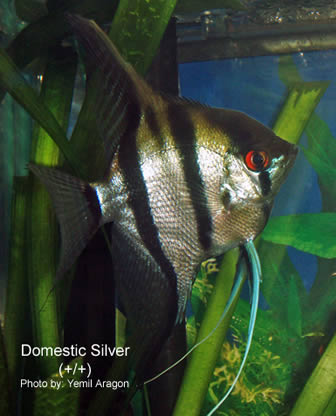
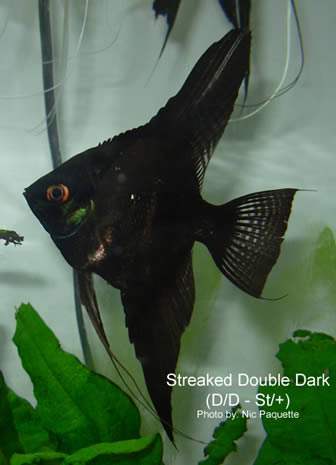
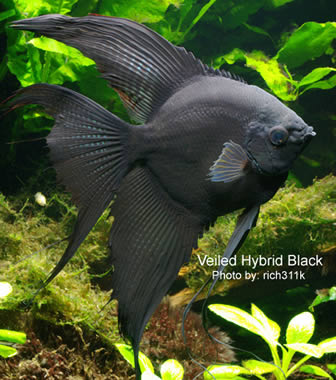

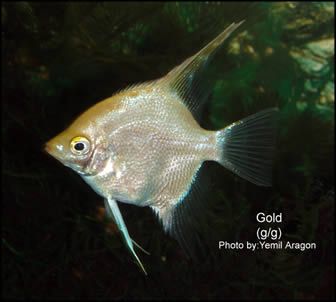
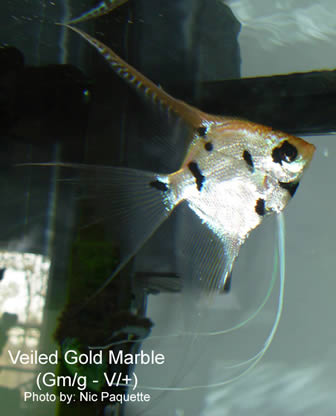
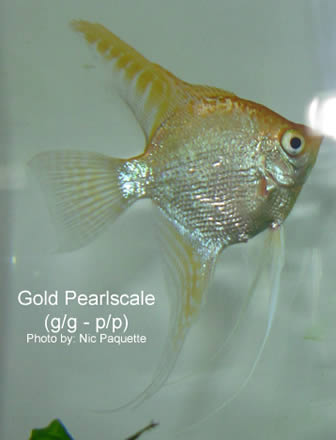
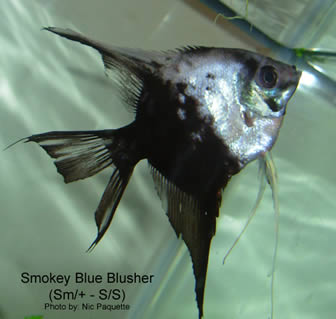
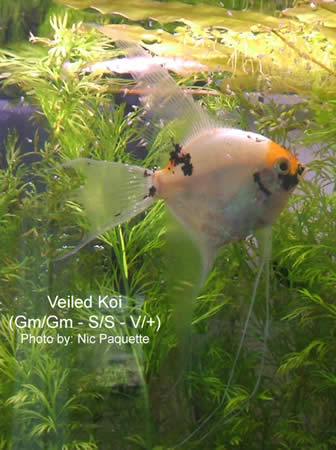
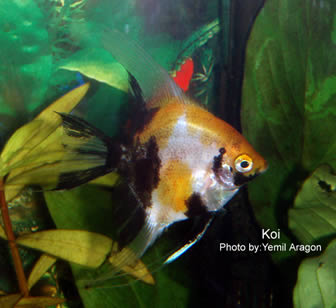
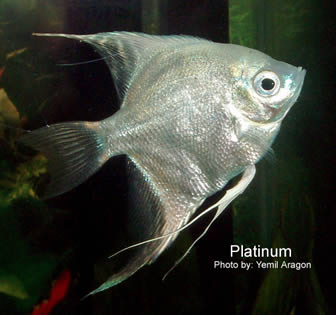
Thanks in large part to Dr. Joanne Norton much is known about the genetics of angelfish. Dr Norton’s work, published between May 1982 and March 1994 in Freshwater and Marine Aquarium magazine, still stands as the cornerstone of what we know today. Similar to the genetics of all vertebrate organisms angelfish carry two copies of each gene, one which is inherited maternally, one which is inherited paternally. Mutations in various genes lead to interesting and unique color and pattering which, through selective breeding, have generated a number of beautiful angelfish phenotypes. Although a number of angelfish phenotypes have been isolated (described below), the details of total chromosome number, and the precise location on these chromosomes has not yet been determined. While a precise genetic location has not been identified, the trem ‘locus’ is used to describe an area where these mutations reside, and independently segregate during reproduction.
Angelfish Genetics
In order to keep things organized angelfish genetics has been standardized to a large degree. Individual loci are represented by the two genes which are present separated by a slash, thus: g/g. Furthermore multiple loci on the same fish are separated by a dash, thus: g/g – S/S. Finally when writing out a cross many people use brackets or parenthesis to separate animals with an X in the middle, thus: (g/g – S/S) X (Sm/Sm – V/V).
Descriptions
Below are descriptions for the currently described (and classified) single gene angelfish phenotypes, as well as a few of the more common multiple gene phenotypes. Please keep in mind that there are literally hundreds of ways in which these genes can be paired together. For a more comprehensive library of both single and multi-gene angelfish phenotypes please visit The Angelfish Society Phenotype Library.
Following the descriptions of the established angelfish mutations are descriptions of ‘new’ mutations that are currently circulating, but have not been completely classified at the time of this write up.
Wild type (Silver)
Wild angelfish known as Wild type (or domestically as Silver), show an overall body shine with 3 vertical body stripes, one in across the eyes, one mid body, and one that extends between the dorsal and anal fins. Most wild type angelfish have red eyes and also show some kind of crown coloration, although this coloring can be lost over multiple generations in captivity. Finally the dorsal, caudal, and anal fins of wild type animals show noticeable striping. Silver angelfish are the ‘standard’ to which all other phenotypes and mutations are compared.
Dark Locus
The Dark locus is perhaps the most complicated, but most vibrant, of all known angelfish phenotypes. Four known mutations have been identified at this locus; Dark (D), Marble (M), Gold Marble (Gm) and Gold (g). Any two of these genes, or a wild type gene can be present at the Dark Locus of an angelfish. Below are brief descriptions of the phenotypes;
Black (or Double Dark) (D/D): Fish containing 2 copies of the Dark gene (D) typically show a completely black body. In some cases there may be noticeable patterning within the black coloring but there is almost never any white present. These fish often have red eyes, and in some cases show blue beards and/or crowns.
Marble (M/M, M/g, M/Gm): Marble angelfish show a black and white marbled patterning. Similar to the double dark phenotype, these fish often have red eyes. Because the marble (M) mutation is dominant to gold (g) both M/M and M/g are considered marble, however M/M fish will typically have more black coloring than M/g fish. These fish are sometimes known by the term ‘panda’. Marble can also be paired with a gold marble gene (Gm). In this combination heavy marbling is seen on the fish along with a yellow/orange crown.
Gold Marble (Gm/Gm, Gm/g): Gold marble angelfish are some of the most common angelfish on the market currently. Gold marble angelfish show a mix of black and white coloring on their main body with a crown of gold or yellow. In some cases this gold/orange patterning can be found throughout the entire body. Because the gold marble (Gm) gene is dominant to gold (g), both Gm/Gm and Gm/g fish are considered gold marble. Gm/Gm fish will typically have more black patterning and deeper/larger orange/yellow coloring than Gm/g fish however.
Gold (g/g): Gold angelfish show an orange/yellow coloration on their entire body, with the peak of color in their crown, typically stretching from their mouth to the top of their dorsal fin, with no black coloring at all. The gold mutation (g) is recessive, thus a fish must have two copies of gold (g/g) to show this color patterning.
Hybrid Black (D/g, D/M, D/Gm): Hybrid black angelfish have one copy of the dark mutation (D), with either a gold (g), marble (M) or gold marble (Gm) mutation. Similar to black (or double dark) a hybrid black angelfish is almost completely black. In the case of hybrid blacks however, the coloration is said to be more ‘milkly’. Because of a slight color difference between the genes, hybrid blacks with marble or gold marble genes can sometimes show subtle patterning, particularly under bright lights or when the fish is stressed. Unlike black angelfish, hybrid blacks show no blue coloration and often do not have red eyes (although this is not always the case).
Black Lace (D/+): Black lace angelfish occur when fish carry one copy of the dark gene (D) and one copy of the wild type gene (+). Because the dark and wild type genes are co-dominant the fish looks similar to a wild type (silver) angelfish with a general darker coloring, however it is never as dark as a black or hybrid black fish.
Silver Marble (M/+): Silver marble angelfish occur when the fish carries one copy of the marble gene (M) and one copy of the wild type gene (+). Similar to black lace, marble is co-dominant to wild type resulting in a blending of the two traits. In this case the fish shows wild type (silver) patterning, with interlaced marble patches. These fish are sometimes referred to as ‘Barred Marble’.
Silver Gold Marble (Gm/+): Silver gold marble angelfish occur when the fish carries one copy of the gold marble gene (Gm) and one wild type gene (+). Gold marble is co-dominant to wild type resulting in a blended appearance. As a result both the gold marble patterning and wild type (silver) patterning are seen, however they are both muted giving the fish a ‘dirty’ appearance.
Zebra Locus
The Zebra locus is likely the second most complicated of all known angelfish loci. The zebra locus can contain two known mutations, Stripeless (S), and Zebra (Z).
Ghost (S/+): Ghost angelfish carry a single copy of the stripeless gene (S), along with a wild type gene (+). Ghost angelfish show no body stripes such as those seen in wild type (silver) angelfish giving them a largely ‘clean’ appearance.
Blushing (S/S): Blushing angelfish carry two copies of the stripeless gene (S). Similar to ghosts, blushing angelfish show now body stripes. In addition the shine of the scales is largely altered. Blushing angelfish show large patches of shiny scales throughout various parts of their body. These fish also have no striped patterning in their anal, dorsal or caudal fins. Some blushing angelfish commonly show blue coloring tints and can sometimes be called ‘Blue Blushers’.
Zebra (Z/+, Z/Z): Zebra angelfish carry one or two copies of the dominant zebra (Z) mutation. Zebra angelfish show 3-5 additional body stripes when compared to wild type (silver) angelfish.
Clown (S/Z): Clown angelfish carry one copy of the stripeless gene (S) and one copy of the zebra gene (Z). Clown angelfish show dark black spots throughout their body, due to a modification of the zebra patterning.
Smokey Locus
Smokey ( Sm/+): Smokey angelfish contain a single copy of the smokey gene (Sm). These fish show blackish coloring in their rear body and fins. This patterning is typically not completely solid and has a ‘rough’ edge where it meets the main body of the fish. These fish typically show a grayish body coloring as well.
Chocolate (Sm/Sm): Chocolate angelfish carry two copies of the smokey gene (Sm). These fish show a dark black/brownish body coloring throughout their entire body with the exception of their head and crown which can still often be seen. Although the blackish body coloring covers most of the body it is often incomplete and may have grey patches.
Veiled Locus
Veiled (V/+): Veiled angelfish occur when the fish carries a single copy of the veiled gene (V). Veiled angelfish show elongated anal, dorsal and caudal fins. These fins, particularly the caudal fin, often show some frilling along the edges. The bodies of veiled angelfish can often be smaller than those of their standard finned clutch mates.
Superveiled (V/V): Superveil angelfish occur when the fish carries two copies of the veiled gene (V). Superveiled angelfish show extremely elongated fins. Because the fins are so long, superveiled angelfish can sometimes appear to have broken or sagging fins. This is particularly present in fish that were grown in small tanks as fry.
Streaked Locus
Streaked (St/+, St/St): Streaked angelfish carry one or two copies of the dominant streaked gene (St). Streaked angelfish show a white streak in their dorsal fin. Because the streak is always white it is typically only noticeable in dark colored fish. Lighter colored fish can still carry this gene however and pass it along to progeny.
Halfblack Locus
Halfblack (h/h): Halfblack angelfish result from carrying two copies of the recessive halfblack gene. Halfblack angelfish show dark black coloring in the rear half of the fish with a sharp boarder, unlike what is seen in smokey angelfish. For unknown reasons the penetrance of halfblack is not always complete and fish that have (h/h) may not always show the correct patterning. As a result expressing halfblack angelfish are one of the more sought after varieties by angelfish breeders.
Pearlscale Locus
Pearlscale (p/p): Pearlscale angelfish result from the fish carrying two copies of the recessive pearlscale (p) gene. Pearlscale angelfish show scales that are malformed causing them to become extremely shiny. Unlike blushing angelfish, pearlscale fish show the pearlscale patterning throughout their entire body.
Albino Locus
Albino (a/a): Albino angelfish result from the presence of two recessive albino (a) genes. Albino angelfish show no coloring, and can hide the coloring of most other genes.
Combinations
Koi: Perhaps the most common multi-gene combination for angelfish is the Koi. Genetically Koi angelfish can have two makeups; (Gm/Gm – S/S) or (Gm/g – S/S). Typically Koi angelfish have pure white bodies, with black spots as well as a yellow/orange crown. Through selective breeding a number of breeders have begun releasing Koi angelfish which show almost complete (or fully complete) yellow/orange body coloring. It is important to note that true Koi angelfish must contain two copies of the Stripeless gene (S/S). This removes all striped patterning from the fins of the fish.
Sunset: Sunset angelfish are another common multi-gene combination with the genetic makeup (g/g – S/S). Sunset angelfish show yellow/orange coloring originating in their crown and in some cases going throughout their entire body. Similar to Koi, true Sunset angelfish have two copies of the Stripeless gene (S), removing all stripes from their fins.
Turquoise Blushing: Turquoise blushing angelfish result from the combination of a dark (D) and stripeless (S) genes; (D/+ - S/S). Turquoise blushing angelfish have a blackish grey body with bright blue gill plate and sometimes dorsal fin. A number of breeders are attempting to selectively breed turquoise blushers in order to obtain predominantly blue angelfish.
Leopard: Leopard angelfish result from the combination of Smokey and Zebra genes with the genetic makeup; (Sm/Sm – Z/+ or Z/Z). Leopard angelfish get their names due to the spotted appearance while they are fry. As they get older leopards become almost completely black (similar to chocolates) sometimes with a bluish head and crown. The fins of Leopard angelfish also show a lacy spotted patterning.
Cobra: Cobra angelfish (also known as Zebra Lace) are produced from a combination of Dark (D) and Zebra (Z) genes; (D/+ - Z/+ or Z/Z). Cobra angelfish show a heavily laced patterning in their fins. While the bodies of the fish do show the typical wild type (Silver) body pattern, the coloring is usually a little darker with hints of green or blue. In many cases these fish will also have red eyes. Cobra angelfish are known to be light sensitive while young. As a result changes in the amount of light the fish are exposed to as fry can change the patterning of the adult fish.
New Phenotypes
German Red: German Red angelfish have become popular in the last few years. Although initially thought to be a modification of the gold gene, it now appears that German Red angelfish result from the presence of two copies of a recessive mutation. As their name implies German Red angelfish have a reddish hue along their entire body. A word of warning however; Some breeders sell ghost angelfish that are fed red food coloring as German Reds. As a result, after purchase the red will disappear from the fish. Obviously these are not true German Reds.
Platinum: Platinum angelfish are another recently discovered type of angelfish. Originally derived from a gold line, platinum angelfish show a white sheen as juveniles and adults, with a tint of green and/or blue. Platinum angelfish are also the result of the presence of two copies of a recessive gene.
